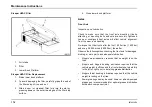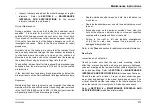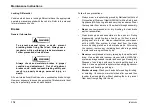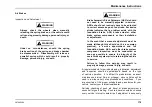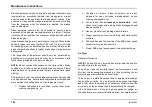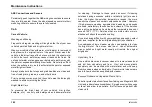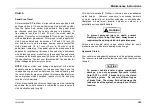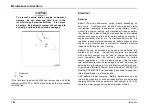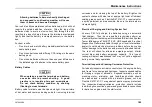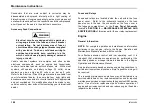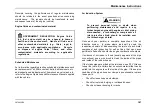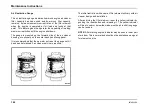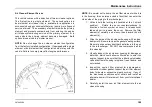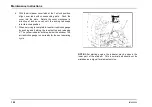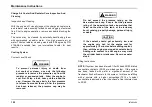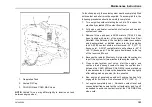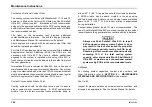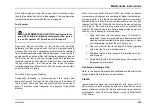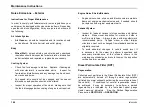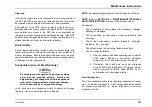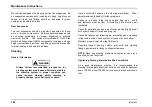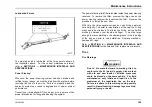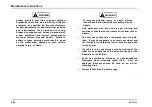
Maintenance Instructions
CAUTION
Allowing batteries to become heavily discharged
and exposed to subfreezing weather will cause
them to freeze and become damaged.
Your vehicle utilizes maintenance-free batteries, which will not
require the periodic addition of water.
Wipe the tops of the
batteries clean to avoid a slow current flow through the dirt,
resulting in a loss of charge. Be sure the terminals are clamped
tightly and that the battery is clamped securely in the battery
box.
For best results:
•
Do not mix and match battery models/manufacturers in the
same battery pack.
•
Do not use batteries with differing CCA ratings in the same
battery pack.
•
Do not use batteries with more than one year difference in
the installed age of batteries in the same battery pack.
Battery Cables
CAUTION
When working around the terminals and battery,
use extra care to prevent shorting.
A good
practice is to insulate pliers and screwdrivers.
Do not check battery condition by shorting
(flashing) across terminals.
Battery cable terminals must be clean and tight. Use a mixture
of hot water and common baking soda for removing terminal
corrosion and for cleaning the top of the battery. Brighten the
contact surfaces with steel wool, apply a light coat of lubricant
sealing grease, such as Fleetrite® 472141-C1 or equivalent or
a spray protectant, and reassemble. Be sure the terminals are
clamped tightly.
Electrical Charging and Starting System Test
At every PM. fully charge the batteries using an automatic
float charger.
Then, have a qualified technician perform an
electrical system test using an International® Electronic System
Tester (Midtronics inTELLECT EXP HD Expandable Electrical
Diagnostics Platform available through your local International
dealer) to catch electrical system problems before they cause
further damage to the batteries and prevent a stranded vehicle.
The test will check for alternator amperage output, starter
current draw, and battery amperage capacity.
This type of
testing will detect weaknesses that may not yet be apparent
during normal daily operations.
Terminal Inspection-Cleaning-Corrosion Protection
Periodically inspect electrical connectors on the engine, battery,
and frame for corrosion and tightness. Inspect exposed cables
for fraying or signs of abrasion. Exposed terminals, such as
cranking motor, alternator, and feed-through studs should
be cleaned and recoated with a dielectric grease, such as
Fleetrite® 472141–C1 or equivalent paste or spray protectant.
The inspection/cleaning/corrosion protection should include
feed-through connections, power and ground cable connections
for batteries, engines, and the starter stud.
3878859R2
185
Содержание ProStar+ Eagle Series.
Страница 4: ...Operator s Manual ProStar Series Printed in the United States of America 3878859R2 ...
Страница 12: ...Table of Contents Section 10 Index Index 235 viii 3878859R2 ...
Страница 26: ...Model Description Exterior Components 14 3878859R2 ...
Страница 28: ...Model Description 16 3878859R2 ...
Страница 59: ...Controls Features 3878859R2 47 ...
Страница 70: ...Controls Features Declination Zone Map 58 3878859R2 ...
Страница 93: ...Controls Features Center Dash Panel Wing Panel 3878859R2 81 ...
Страница 128: ...Sleeper Features 116 3878859R2 ...
Страница 182: ...Operation 170 3878859R2 ...
Страница 241: ...Maintenance Intervals and Specifications Typical Interior Fuse Panel Layout 3878859R2 229 ...
Страница 242: ...Maintenance Intervals and Specifications Typical Luggage Compartment Fuse Panel Layout 230 3878859R2 ...
Страница 262: ...Index 250 3878859R2 ...






